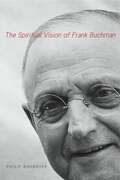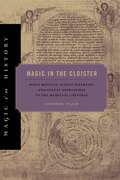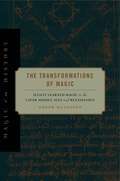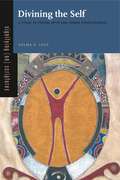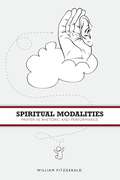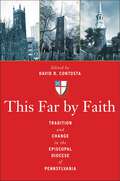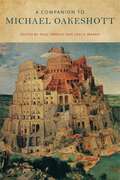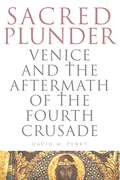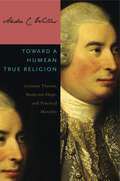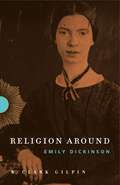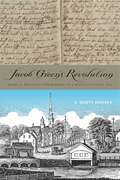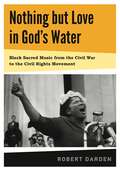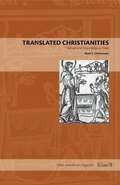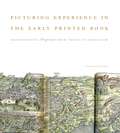- Table View
- List View
The Spiritual Vision of Frank Buchman
by Philip BoobbyerThe Spiritual Vision of Frank Buchman is an in-depth look at the life, spirituality, and ideology of one of the most original figures in twentieth-century religion. Frank Buchman (1878–1961), the Pennsylvania-born initiator of the movement known as the Oxford Group and Moral Re-Armament, was a Lutheran pastor who first had influence as a college evangelist and missionary with the YMCA. His thinking then evolved during the 1930s, the Second World War, and the early Cold War as he tried to develop a world philosophy that could offer an answer to war and materialism. His impact was particularly felt in the areas of conflict resolution between nations and interfaith dialogue, and Alcoholics Anonymous also owed much to his methods. Philip Boobbyer’s book is the first scholarly overview of Buchman’s ideas and is an important addition to the growing corpus of academic literature on his worldwide outreach. Boobbyer shows how his work reflected broader processes in twentieth-century religion and politics and can be seen as a spiritual response to an emerging global society.
Magic in the Cloister: Pious Motives, Illicit Interests, and Occult Approaches to the Medieval Universe (Magic in History)
by Sophie PageDuring the late thirteenth and early fourteenth centuries a group of monks with occult interests donated what became a remarkable collection of more than thirty magic texts to the library of the Benedictine abbey of St. Augustine's in Canterbury. The monks collected texts that provided positive justifications for the practice of magic and books in which works of magic were copied side by side with works of more licit genres. In Magic in the Cloister, Sophie Page uses this collection to explore the gradual shift toward more positive attitudes to magical texts and ideas in medieval Europe. She examines what attracted monks to magic texts, works, and how they combined magic with their intellectual interests and monastic life. By showing how it was possible for religious insiders to integrate magical studies with their orthodox worldview, Magic in the Cloister contributes to a broader understanding of the role of magical texts and ideas and their acceptance in the late Middle Ages.
Magic in the Cloister: Pious Motives, Illicit Interests, and Occult Approaches to the Medieval Universe (Magic in History)
by Sophie PageDuring the late thirteenth and early fourteenth centuries a group of monks with occult interests donated what became a remarkable collection of more than thirty magic texts to the library of the Benedictine abbey of St. Augustine's in Canterbury. The monks collected texts that provided positive justifications for the practice of magic and books in which works of magic were copied side by side with works of more licit genres. In Magic in the Cloister, Sophie Page uses this collection to explore the gradual shift toward more positive attitudes to magical texts and ideas in medieval Europe. She examines what attracted monks to magic texts, works, and how they combined magic with their intellectual interests and monastic life. By showing how it was possible for religious insiders to integrate magical studies with their orthodox worldview, Magic in the Cloister contributes to a broader understanding of the role of magical texts and ideas and their acceptance in the late Middle Ages.
The Transformations of Magic: Illicit Learned Magic in the Later Middle Ages and Renaissance (Magic in History)
by Frank KlaassenIn this original, provocative, well-reasoned, and thoroughly documented book, Frank Klaassen proposes that two principal genres of illicit learned magic occur in late medieval manuscripts: image magic, which could be interpreted and justified in scholastic terms, and ritual magic (in its extreme form, overt necromancy), which could not. Image magic tended to be recopied faithfully; ritual magic tended to be adapted and reworked. These two forms of magic did not usually become intermingled in the manuscripts, but were presented separately. While image magic was often copied in the fourteenth and fifteenth centuries, The Transformations of Magic demonstrates that interest in it as an independent genre declined precipitously around 1500. Instead, what persisted was the other, more problematic form of magic: ritual magic. Klaassen shows that texts of medieval ritual magic were cherished in the sixteenth century, and writers of new magical treatises, such as Agrippa von Nettesheim and John Dee, were far more deeply indebted to medieval tradition—and specifically to the medieval tradition of ritual magic—than previous scholars have thought them to be.
The Transformations of Magic: Illicit Learned Magic in the Later Middle Ages and Renaissance (Magic in History)
by Frank KlaassenIn this original, provocative, well-reasoned, and thoroughly documented book, Frank Klaassen proposes that two principal genres of illicit learned magic occur in late medieval manuscripts: image magic, which could be interpreted and justified in scholastic terms, and ritual magic (in its extreme form, overt necromancy), which could not. Image magic tended to be recopied faithfully; ritual magic tended to be adapted and reworked. These two forms of magic did not usually become intermingled in the manuscripts, but were presented separately. While image magic was often copied in the fourteenth and fifteenth centuries, The Transformations of Magic demonstrates that interest in it as an independent genre declined precipitously around 1500. Instead, what persisted was the other, more problematic form of magic: ritual magic. Klaassen shows that texts of medieval ritual magic were cherished in the sixteenth century, and writers of new magical treatises, such as Agrippa von Nettesheim and John Dee, were far more deeply indebted to medieval tradition—and specifically to the medieval tradition of ritual magic—than previous scholars have thought them to be.
Divining the Self: A Study in Yoruba Myth and Human Consciousness (Signifying (on) Scriptures #1)
by Velma E. LoveDivining the Self weaves elements of personal narrative, myth, history, and interpretive analysis into a vibrant tapestry that reflects the textured, embodied, and performative nature of scripture and scripturalizing practices. Velma Love examines the Odu—the Yoruba sacred scriptures—along with the accompanying mythology, philosophy, and ritual technologies engaged by African Americans. Drawing from the personal narratives of African American Ifa practitioners along with additional ethnographic fieldwork conducted in Oyotunji African Village, South Carolina, and New York City, Love’s work explores the ways in which an ancient worldview survives in modern times. Divining the Self also takes up the challenge of determining what it means for the scholar of religion to study scripture as both text and performance. This work provides an excellent case study of the sociocultural phenomenon of scripturalizing practices.
Divining the Self: A Study in Yoruba Myth and Human Consciousness (Signifying (on) Scriptures)
by Velma E. LoveDivining the Self weaves elements of personal narrative, myth, history, and interpretive analysis into a vibrant tapestry that reflects the textured, embodied, and performative nature of scripture and scripturalizing practices. Velma Love examines the Odu—the Yoruba sacred scriptures—along with the accompanying mythology, philosophy, and ritual technologies engaged by African Americans. Drawing from the personal narratives of African American Ifa practitioners along with additional ethnographic fieldwork conducted in Oyotunji African Village, South Carolina, and New York City, Love’s work explores the ways in which an ancient worldview survives in modern times. Divining the Self also takes up the challenge of determining what it means for the scholar of religion to study scripture as both text and performance. This work provides an excellent case study of the sociocultural phenomenon of scripturalizing practices.
Spiritual Modalities: Prayer as Rhetoric and Performance
by William FitzGeraldA bold recasting of prayer as a rhetorical art, Spiritual Modalities investigates situations, strategies, and performative modes of discourse directed to divine audiences. Examining how prayer “works,” Spiritual Modalities reads prayer’s situations and strategies, its characteristic acts and attitudes, to advance an understanding of prayer as a basic expression of our rhetorical capacities for communication and communion. This groundbreaking analysis demonstrates how prayer draws on fundamental capacities to engage other beings rhetorically to argue that we are never more human than when we address the nonhuman. Spiritual Modalities is notable in its aim to articulate a critical rhetoric of prayer in a secular idiom. It draws on contributions to rhetorical theory from Kenneth Burke along with a broad range of classical and contemporary perspectives on audience, address, speech acts, and modes of performance. The book also takes a multicultural and multimodal approach to prayer as rhetorical performance. The texts and practices of prayer represented range across religious traditions and historical eras and include both verbal and physical modes of divine address. The book will be of interest to scholars researching religious language, Burkean approaches to discourse, practices of memory, and media studies.
Spiritual Modalities: Prayer as Rhetoric and Performance
by William FitzGeraldA bold recasting of prayer as a rhetorical art, Spiritual Modalities investigates situations, strategies, and performative modes of discourse directed to divine audiences. Examining how prayer “works,” Spiritual Modalities reads prayer’s situations and strategies, its characteristic acts and attitudes, to advance an understanding of prayer as a basic expression of our rhetorical capacities for communication and communion. This groundbreaking analysis demonstrates how prayer draws on fundamental capacities to engage other beings rhetorically to argue that we are never more human than when we address the nonhuman. Spiritual Modalities is notable in its aim to articulate a critical rhetoric of prayer in a secular idiom. It draws on contributions to rhetorical theory from Kenneth Burke along with a broad range of classical and contemporary perspectives on audience, address, speech acts, and modes of performance. The book also takes a multicultural and multimodal approach to prayer as rhetorical performance. The texts and practices of prayer represented range across religious traditions and historical eras and include both verbal and physical modes of divine address. The book will be of interest to scholars researching religious language, Burkean approaches to discourse, practices of memory, and media studies.
This Far by Faith: Tradition and Change in the Episcopal Diocese of Pennsylvania
by David R. ContostaThe history of the Diocese of Pennsylvania is in many ways a history of the Episcopal Church at large. It remains one of the largest and most influential dioceses in the national church. Its story has paralleled and illustrated the challenges and accomplishments of the wider denomination—and of issues that concern the American people as a whole. In This Far by Faith, ten professional historians provide the first complete history of the Diocese of Pennsylvania. It will become essential reading for anyone wishing to understand the history and significance of the Episcopal Church and of its evolution in the Greater Philadelphia area.Aside from the editor, the contributors are Charles Cashdollar, Marie Conn, William W. Cutler III, Deborah Mathias Gough, Ann Greene, Sheldon Hackney, Emma J. Lapsansky-Werner, William Pencak, and Thomas F. Rzeznik.
This Far by Faith: Tradition and Change in the Episcopal Diocese of Pennsylvania
by David R. ContostaThe history of the Diocese of Pennsylvania is in many ways a history of the Episcopal Church at large. It remains one of the largest and most influential dioceses in the national church. Its story has paralleled and illustrated the challenges and accomplishments of the wider denomination—and of issues that concern the American people as a whole. In This Far by Faith, ten professional historians provide the first complete history of the Diocese of Pennsylvania. It will become essential reading for anyone wishing to understand the history and significance of the Episcopal Church and of its evolution in the Greater Philadelphia area.Aside from the editor, the contributors are Charles Cashdollar, Marie Conn, William W. Cutler III, Deborah Mathias Gough, Ann Greene, Sheldon Hackney, Emma J. Lapsansky-Werner, William Pencak, and Thomas F. Rzeznik.
A Companion to Michael Oakeshott
by Paul Franco Leslie MarshMichael Oakeshott has long been recognized as one of the most important political philosophers of the twentieth century, but until now no single volume has been able to examine all the facets of his wide-ranging philosophy with sufficient depth, expertise, and authority. The essays collected here cover all aspects of Oakeshott’s thought, from his theory of knowledge and philosophies of history, religion, art, and education to his reflections on morality, politics, and law. Aside from the editors, the contributors are Corey Abel, David Boucher, Elizabeth Corey, Robert Devigne, Timothy Fuller, Steven Gerencser, Robert Grant, Noel Malcolm, Kenneth McIntyre, Kenneth Minogue, Noël O’Sullivan, Geoffrey Thomas, and Martyn Thompson.
A Companion to Michael Oakeshott
by Paul Franco, Leslie MarshMichael Oakeshott has long been recognized as one of the most important political philosophers of the twentieth century, but until now no single volume has been able to examine all the facets of his wide-ranging philosophy with sufficient depth, expertise, and authority. The essays collected here cover all aspects of Oakeshott’s thought, from his theory of knowledge and philosophies of history, religion, art, and education to his reflections on morality, politics, and law. Aside from the editors, the contributors are Corey Abel, David Boucher, Elizabeth Corey, Robert Devigne, Timothy Fuller, Steven Gerencser, Robert Grant, Noel Malcolm, Kenneth McIntyre, Kenneth Minogue, Noël O’Sullivan, Geoffrey Thomas, and Martyn Thompson.
Sacred Plunder: Venice and the Aftermath of the Fourth Crusade (G - Reference, Information and Interdisciplinary Subjects)
by David M. PerryIn Sacred Plunder, David Perry argues that plundered relics, and narratives about them, played a central role in shaping the memorial legacy of the Fourth Crusade and the development of Venice’s civic identity in the thirteenth century. After the Fourth Crusade ended in 1204, the disputes over the memory and meaning of the conquest began. Many crusaders faced accusations of impiety, sacrilege, violence, and theft. In their own defense, they produced hagiographical narratives about the movement of relics—a medieval genre called translatio—that restated their own versions of events and shaped the memory of the crusade. The recipients of relics commissioned these unique texts in order to exempt both the objects and the people involved with their theft from broader scrutiny or criticism. Perry further demonstrates how these narratives became a focal point for cultural transformation and an argument for the creation of the new Venetian empire as the city moved from an era of mercantile expansion to one of imperial conquest in the thirteenth century.
Sacred Plunder: Venice and the Aftermath of the Fourth Crusade
by David M. PerryIn Sacred Plunder, David Perry argues that plundered relics, and narratives about them, played a central role in shaping the memorial legacy of the Fourth Crusade and the development of Venice’s civic identity in the thirteenth century. After the Fourth Crusade ended in 1204, the disputes over the memory and meaning of the conquest began. Many crusaders faced accusations of impiety, sacrilege, violence, and theft. In their own defense, they produced hagiographical narratives about the movement of relics—a medieval genre called translatio—that restated their own versions of events and shaped the memory of the crusade. The recipients of relics commissioned these unique texts in order to exempt both the objects and the people involved with their theft from broader scrutiny or criticism. Perry further demonstrates how these narratives became a focal point for cultural transformation and an argument for the creation of the new Venetian empire as the city moved from an era of mercantile expansion to one of imperial conquest in the thirteenth century.
Toward a Humean True Religion: Genuine Theism, Moderate Hope, and Practical Morality
by Andre C. WillisDavid Hume is traditionally seen as a devastating critic of religion. He is widely read as an infidel, a critic of the Christian faith, and an attacker of popular forms of worship. His reputation as irreligious is well forged among his readers, and his argument against miracles sits at the heart of the narrative overview of his work that perennially indoctrinates thousands of first-year philosophy students. In Toward a Humean True Religion, Andre Willis succeeds in complicating Hume’s split approach to religion, showing that Hume was not, in fact, dogmatically against religion in all times and places. Hume occupied a “watershed moment,” Willis contends, when old ideas of religion were being replaced by the modern idea of religion as a set of epistemically true but speculative claims. Thus, Willis repositions the relative weight of Hume’s antireligious sentiment, giving significance to the role of both historical and discursive forces instead of simply relying on Hume’s personal animus as its driving force. Willis muses about what a Humean “true religion” might look like and suggests that we think of this as a third way between the classical and modern notions of religion. He argues that the cumulative achievements of Hume’s mild philosophic theism, the aim of his moral rationalism, and the conclusion of his project on the passions provide the best content for this “true religion.”
Toward a Humean True Religion: Genuine Theism, Moderate Hope, and Practical Morality
by Andre C. WillisDavid Hume is traditionally seen as a devastating critic of religion. He is widely read as an infidel, a critic of the Christian faith, and an attacker of popular forms of worship. His reputation as irreligious is well forged among his readers, and his argument against miracles sits at the heart of the narrative overview of his work that perennially indoctrinates thousands of first-year philosophy students. In Toward a Humean True Religion, Andre Willis succeeds in complicating Hume’s split approach to religion, showing that Hume was not, in fact, dogmatically against religion in all times and places. Hume occupied a “watershed moment,” Willis contends, when old ideas of religion were being replaced by the modern idea of religion as a set of epistemically true but speculative claims. Thus, Willis repositions the relative weight of Hume’s antireligious sentiment, giving significance to the role of both historical and discursive forces instead of simply relying on Hume’s personal animus as its driving force. Willis muses about what a Humean “true religion” might look like and suggests that we think of this as a third way between the classical and modern notions of religion. He argues that the cumulative achievements of Hume’s mild philosophic theism, the aim of his moral rationalism, and the conclusion of his project on the passions provide the best content for this “true religion.”
Religion Around Emily Dickinson (Religion Around #2)
by W. Clark GilpinReligion Around Emily Dickinson begins with a seeming paradox posed by Dickinson’s posthumously published works: while her poems and letters contain many explicitly religious themes and concepts, throughout her life she resisted joining her local church and rarely attended services. Prompted by this paradox, W. Clark Gilpin proposes, first, that understanding the religious aspect of the surrounding culture enhances our appreciation of Emily Dickinson’s poetry and, second, that her poetry casts light on features of religion in nineteenth-century America that might otherwise escape our attention. Religion, especially Protestant Christianity, was “around” Emily Dickinson not only in explicitly religious practices, literature, architecture, and ideas but also as an embedded influence on normative patterns of social organization in the era, including gender roles, education, and ideals of personal intimacy and fulfillment. Through her poetry, Dickinson imaginatively reshaped this richly textured religious inheritance to create her own personal perspective on what it might mean to be religious in the nineteenth century. The artistry of her poetry and the profundity of her thought have meant that this personal perspective proved to be far more than “merely” personal. Instead, Dickinson’s creative engagement with the religion around her has stimulated and challenged successive generations of readers in the United States and around the world.
Religion Around Emily Dickinson (Religion Around)
by W. Clark GilpinReligion Around Emily Dickinson begins with a seeming paradox posed by Dickinson’s posthumously published works: while her poems and letters contain many explicitly religious themes and concepts, throughout her life she resisted joining her local church and rarely attended services. Prompted by this paradox, W. Clark Gilpin proposes, first, that understanding the religious aspect of the surrounding culture enhances our appreciation of Emily Dickinson’s poetry and, second, that her poetry casts light on features of religion in nineteenth-century America that might otherwise escape our attention. Religion, especially Protestant Christianity, was “around” Emily Dickinson not only in explicitly religious practices, literature, architecture, and ideas but also as an embedded influence on normative patterns of social organization in the era, including gender roles, education, and ideals of personal intimacy and fulfillment. Through her poetry, Dickinson imaginatively reshaped this richly textured religious inheritance to create her own personal perspective on what it might mean to be religious in the nineteenth century. The artistry of her poetry and the profundity of her thought have meant that this personal perspective proved to be far more than “merely” personal. Instead, Dickinson’s creative engagement with the religion around her has stimulated and challenged successive generations of readers in the United States and around the world.
Jacob Green’s Revolution: Radical Religion and Reform in a Revolutionary Age
by S. Scott RohrerPart biography and part microhistory, Jacob Green’s Revolution focuses on two key figures in New Jersey’s revolutionary drama—Jacob Green, a radical Presbyterian minister who advocated revolution, and Thomas Bradbury Chandler, a conservative Anglican minister from Elizabeth Town who was a leading loyalist spokesman in America. Both men were towering intellects who were shaped by Puritan culture and the Enlightenment, and both became acclaimed writers and leading figures in New Jersey—Green for the rebelling colonists, Chandler for the king. Through their stories, this book examines the ways in which religion influenced reform during a pivotal time in American history.
Nothing but Love in God's Water: Volume 1: Black Sacred Music from the Civil War to the Civil Rights Movement
by Robert DardenThe first of two volumes chronicling the history and role of music in the African American experience, Nothing but Love in God’s Water explores how songs and singers helped African Americans challenge and overcome slavery, subjugation, and suppression. From the spirituals of southern fields and the ringing chords of black gospel to the protest songs that changed the landscape of labor and the cadences sung before dogs and water cannons in Birmingham, sacred song has stood center stage in the African American drama. Myriad interviews, one-of-a-kind sources, and rare or lost recordings are used to examine this enormously persuasive facet of the movement. Nothing but Love in God’s Water explains the historical significance of song and helps us understand how music enabled the civil rights movement to challenge the most powerful nation on the planet.
Nothing but Love in God's Water: Volume 1: Black Sacred Music from the Civil War to the Civil Rights Movement
by Robert DardenThe first of two volumes chronicling the history and role of music in the African American experience, Nothing but Love in God’s Water explores how songs and singers helped African Americans challenge and overcome slavery, subjugation, and suppression. From the spirituals of southern fields and the ringing chords of black gospel to the protest songs that changed the landscape of labor and the cadences sung before dogs and water cannons in Birmingham, sacred song has stood center stage in the African American drama. Myriad interviews, one-of-a-kind sources, and rare or lost recordings are used to examine this enormously persuasive facet of the movement. Nothing but Love in God’s Water explains the historical significance of song and helps us understand how music enabled the civil rights movement to challenge the most powerful nation on the planet.
Translated Christianities: Nahuatl and Maya Religious Texts (Latin American Originals #8)
by Mark Z. ChristensenBeginning in the sixteenth century, ecclesiastics and others created religious texts written in the native languages of the Nahua and Yucatec Maya. These texts played an important role in the evangelization of central Mexico and Yucatan. Translated Christianities is the first book to provide readers with English translations of a variety of Nahuatl and Maya religious texts. It pulls Nahuatl and Maya sermons, catechisms, and confessional manuals out of relative obscurity and presents them to the reader in a way that illustrates similarities, differences, and trends in religious text production throughout the colonial period. The texts included in this work are diverse. Their authors range from Spanish ecclesiastics to native assistants, from Catholics to Methodists, and from sixteenth-century Nahuas to nineteenth-century Maya. Although translated from its native language into English, each text illustrates the impact of European and native cultures on its content. Medieval tales popular in Europe are transformed to accommodate a New World native audience, biblical figures assume native identities, and texts admonishing Christian behavior are tailored to meet the demands of a colonial native population. Moreover, the book provides the first translation and analysis of a Methodist catechism written in Yucatec Maya to convert the Maya of Belize and Yucatan. Ultimately, readers are offered an uncommon opportunity to read for themselves the translated Christianities that Nahuatl and Maya texts contained.
Translated Christianities: Nahuatl and Maya Religious Texts (Latin American Originals)
by Mark Z. ChristensenBeginning in the sixteenth century, ecclesiastics and others created religious texts written in the native languages of the Nahua and Yucatec Maya. These texts played an important role in the evangelization of central Mexico and Yucatan. Translated Christianities is the first book to provide readers with English translations of a variety of Nahuatl and Maya religious texts. It pulls Nahuatl and Maya sermons, catechisms, and confessional manuals out of relative obscurity and presents them to the reader in a way that illustrates similarities, differences, and trends in religious text production throughout the colonial period. The texts included in this work are diverse. Their authors range from Spanish ecclesiastics to native assistants, from Catholics to Methodists, and from sixteenth-century Nahuas to nineteenth-century Maya. Although translated from its native language into English, each text illustrates the impact of European and native cultures on its content. Medieval tales popular in Europe are transformed to accommodate a New World native audience, biblical figures assume native identities, and texts admonishing Christian behavior are tailored to meet the demands of a colonial native population. Moreover, the book provides the first translation and analysis of a Methodist catechism written in Yucatec Maya to convert the Maya of Belize and Yucatan. Ultimately, readers are offered an uncommon opportunity to read for themselves the translated Christianities that Nahuatl and Maya texts contained.
Picturing Experience in the Early Printed Book: Breydenbach’s Peregrinatio from Venice to Jerusalem
by Elizabeth RossBernhard von Breydenbach’s Peregrinatio in terram sanctam (Journey to the Holy Land), first published in 1486, is one of the seminal books of early printing and is especially renowned for the originality of its woodcuts. In Picturing Experience in the Early Printed Book, Elizabeth Ross considers the Peregrinatio from a variety of perspectives to explain its value for the cultural history of the period. Breydenbach, a high-ranking cleric in Mainz, recruited the painter Erhard Reuwich of Utrecht for a religious and artistic adventure in a political hot spot—a pilgrimage to research the peoples, places, plants, and animals of the Levant. The book they published after their return ambitiously engaged with the potential of the new print medium to give an account of their experience.The Peregrinatio also aspired to rouse readers to a new crusade against Islam by depicting a contest in the Mediterranean between the Christian bastion of the city of Venice and the region’s Muslim empires. This crusading rhetoric fit neatly with the state of the printing industry in Mainz, which largely subsisted as a tool for bishops’ consolidation of authority, including selling the pope’s plans to combat the Ottoman Empire.Taking an artist on such an enterprise was unprecedented. Reuwich set a new benchmark for technical achievement with his woodcuts, notably a panorama of Venice that folds out to 1.62 meters in length and a foldout map that stretches from Damascus to Sudan around the first topographically accurate view of Jerusalem. The conception and execution of the Peregrinatio show how and why early printed books constructed new means of visual representation from existing ones—and how the form of a printed book emerged out of the interaction of eyewitness experience and medieval scholarship, real travel and spiritual pilgrimage, curiosity and fixed belief, texts and images.
